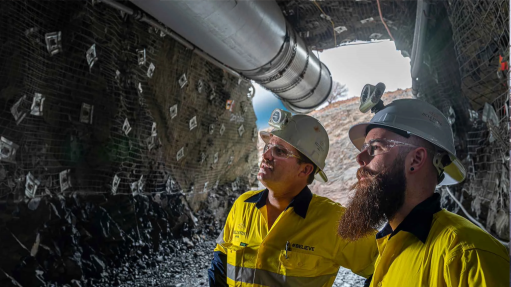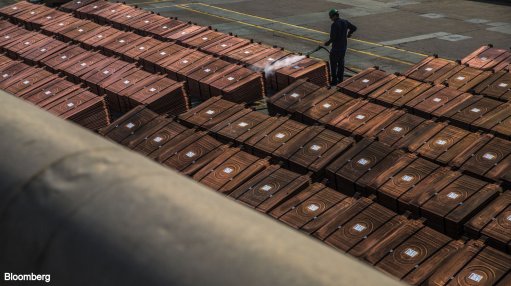State of Disaster and what it means for Mines
This article has been supplied as a media statement and is not written by Creamer Media. It may be available only for a limited time on this website.
On 15 March 2020, following the recent outbreak of COVID-19 in South Africa, president Cyril Ramaphosa announced that a national state of disaster has been declared in terms of the Disaster Management Act, 2002 (“the DMA”).
The purpose of this declaration is to enable the country to embark on an integrated and coordinated approach to prevent and reduce the further outbreak of COVID-19.
What is a national disaster?
The DMA defines a disaster as “a progressive or sudden, widespread or localised natural or human caused occurrence which—
(a) causes or threatens to cause—
(i) death, injury or disease;
(ii) damage to property, infrastructure or the environment; or
(iii) significant disruption of the life of a community; and
(b) is of a magnitude that exceeds the ability of those affected by the disaster to cope with its effects using only their own resources.”
It is evident from the above that the outbreak of COVID-19 falls squarely within this definition.
This declaration enables the Minister of Cooperative Governance and Traditional Affairs (“the Minister”) to make regulations or issue directions, to the extent that it is necessary for the purpose of: assisting and protecting the public; providing relief to the public; protecting property; preventing or combatting disruption; or dealing with the destructive nature and other effects of the disaster. The declaration of COVID-19, as a national disaster will automatically lapse within 3 months but may be terminated sooner, if required.
Mining companies, which are under a legal obligation to create and maintain a safe working environment for mine workers, now need to determine what this declaration means for them.
Workplace Preparedness: COVID – 19 (SARS-CoV-19 virus)
The Department of Employment and Labour have released COVID-19 planning guidance titled
Workplace Preparedness: COVID – 19 (SARS-CoV-19 virus) (“the Guidance Note”).
The Guidance Note was developed based on traditional infection prevention and occupational hygiene practices. It focuses on the need for employers to implement measures which will assist in combating and preventing an outbreak amongst its employees. These measures include engineering, administrative, and work practice controls, as well as personal protective equipment (“PPE”).
The Guidance Note begins by classifying the risk of worker exposure to SARS-CoV-2 into four risk categories:
-
Lower exposure risk (caution)
-
Medium exposure risk
-
High exposure risk
-
Very high exposure risk
In terms of the classifications provided in the Guidance Note, mine workers are likely to fall under the medium exposure risk threshold. This category includes jobs where there is frequent and/or close contact (i.e. within 2 meters) of people who may be infected with the virus, but who are not known or suspected to be COVID-19 patients.
The Guidance Note considers the implementation of workplace controls. It recognises that the Occupational Health and Safety Act, 1993 (“OHSA”) requires that an employer, as far as is reasonably practicable, must provide and maintain a working environment that is safe and without risks to the health of its employees. This includes taking steps to eliminate or mitigate any hazard or potential hazard.
In order to implement control measures, an employer’s existing risk assessment must be reviewed and updated taking into account the new hazards posed by exposure to COVID-19 in the workplace. The following useful figure appears in the Guidance Note.
What does this mean for our mines?
While the OHSA mentioned in the Guidance Note applies more broadly, the Mine Health and Safety Act, 1996 (“MHSA”) applies specifically to mines. Like the OHSA, the MHSA requires employers of mines to ensure, as far as reasonably practicable, that the mine is designed, constructed and equipped to provide conditions for safe operation and a healthy working environment, with a communication system and equipment necessary to achieve these conditions.
The employer is further required to ensure, as far as reasonably practicable, that the mine is operated in a way that employees can perform their work without endangering their own, or other persons’ health or safety.
The MHSA places a duty on every employer to identify hazards to health or safety which employees may be exposed to at work and to assess the risks, record them and make the records available to employees.
There is a further duty on the employer to consult with the mine’s health and safety committee and to determine, and then implement, all measures necessary to eliminate, control, minimise and monitor the risk.
Practical suggestions for mines
It is recommended, in the current circumstances, that the following immediate steps be taken, if same has not been done already:
-
The employer must consult with the mine’s health and safety committee and the existing risk assessment should be reviewed and updated to cater for the new and current risk of COVID-19.
-
Measures will then need to be implemented to give effect to the mine’s obligation to maintain a safe and healthy environment for its workers.
-
Employees should immediately be consulted and advised that these processes are in place. They should also be advised of any interim measures to be followed pending the finalisation of the updated risk assessment.
-
To the extent that there will be a temporary disruption in the operation or production, it is suggested that the mine should advise the DMRE of this. This should be recorded in writing, and if necessary, a section 102 application should be lodged requesting the consent of the Minister to amend the Mining Work Programme should it be necessary.
-
If COVID-19 or the effects thereof, require the mine to drastically reduce its operations or to temporarily close (i.e. to go into care and maintenance) it is suggested that this be communicated to the DMRE as soon as possible. It should clearly be explained why these measures have been taken, and that they are intended to be of a temporary nature in response to the declaration of the national disaster and that the mine does not intend to trigger listed activity 22 of Listing Notice 1, 2014 (which deals with the reduction of operations by 90% and closure) but to resume operations once the disaster has subsided. This approach will mitigate the risk of a notice in terms of section 47 being issued, which may call for the mining right to be suspended or cancelled.
-
Compliance with environmental legislation must continue during this time to ensure that there is no significant adverse impact on the environment.
NUPEN STAUDE DE VRIES
Mining and Environmental Team
Lili Nupen (Director);
Nicole Limberis-Ritchie (Senior Associate); Chantal Murdock (Senior Associate)
Comments
Press Office
Announcements
What's On
Subscribe to improve your user experience...
Option 1 (equivalent of R125 a month):
Receive a weekly copy of Creamer Media's Engineering News & Mining Weekly magazine
(print copy for those in South Africa and e-magazine for those outside of South Africa)
Receive daily email newsletters
Access to full search results
Access archive of magazine back copies
Access to Projects in Progress
Access to ONE Research Report of your choice in PDF format
Option 2 (equivalent of R375 a month):
All benefits from Option 1
PLUS
Access to Creamer Media's Research Channel Africa for ALL Research Reports, in PDF format, on various industrial and mining sectors
including Electricity; Water; Energy Transition; Hydrogen; Roads, Rail and Ports; Coal; Gold; Platinum; Battery Metals; etc.
Already a subscriber?
Forgotten your password?
Receive weekly copy of Creamer Media's Engineering News & Mining Weekly magazine (print copy for those in South Africa and e-magazine for those outside of South Africa)
➕
Recieve daily email newsletters
➕
Access to full search results
➕
Access archive of magazine back copies
➕
Access to Projects in Progress
➕
Access to ONE Research Report of your choice in PDF format
RESEARCH CHANNEL AFRICA
R4500 (equivalent of R375 a month)
SUBSCRIBEAll benefits from Option 1
➕
Access to Creamer Media's Research Channel Africa for ALL Research Reports on various industrial and mining sectors, in PDF format, including on:
Electricity
➕
Water
➕
Energy Transition
➕
Hydrogen
➕
Roads, Rail and Ports
➕
Coal
➕
Gold
➕
Platinum
➕
Battery Metals
➕
etc.
Receive all benefits from Option 1 or Option 2 delivered to numerous people at your company
➕
Multiple User names and Passwords for simultaneous log-ins
➕
Intranet integration access to all in your organisation

















